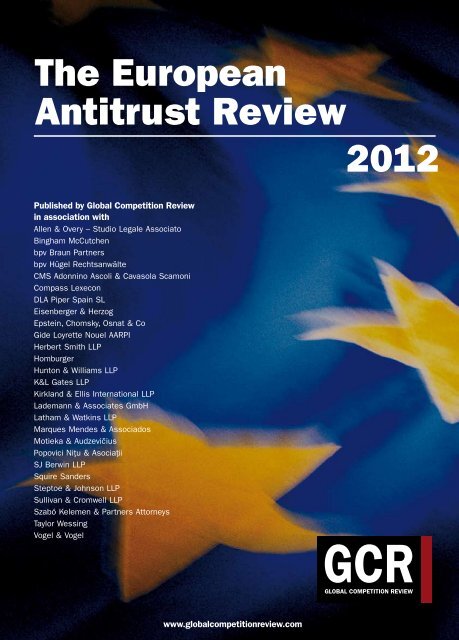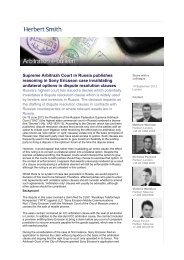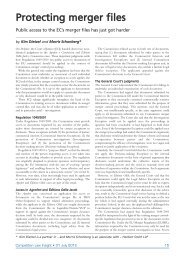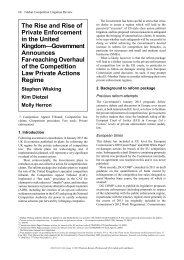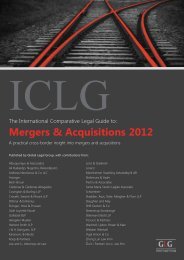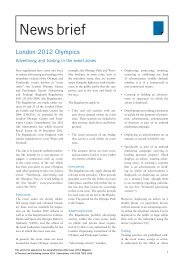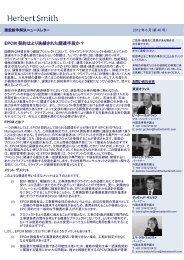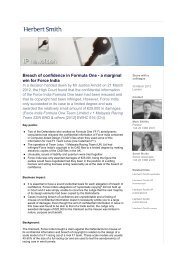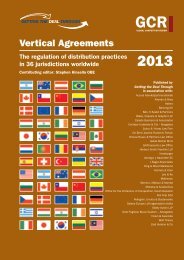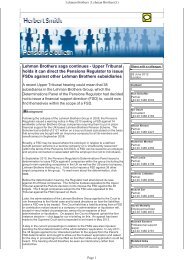The European Antitrust Review 2012 - Herbert Smith Freehills
The European Antitrust Review 2012 - Herbert Smith Freehills
The European Antitrust Review 2012 - Herbert Smith Freehills
Create successful ePaper yourself
Turn your PDF publications into a flip-book with our unique Google optimized e-Paper software.
<strong>The</strong> <strong>European</strong><strong>Antitrust</strong> <strong>Review</strong><strong>2012</strong>Published by Global Competition <strong>Review</strong>in association withAllen & Overy – Studio Legale AssociatoBingham McCutchenbpv Braun Partnersbpv Hügel RechtsanwälteCMS Adonnino Ascoli & Cavasola ScamoniCompass LexeconDLA Piper Spain SLEisenberger & HerzogEpstein, Chomsky, Osnat & CoGide Loyrette Nouel AARPI<strong>Herbert</strong> <strong>Smith</strong> LLPHomburgerHunton & Williams LLPK&L Gates LLPKirkland & Ellis International LLPLademann & Associates GmbHLatham & Watkins LLPMarques Mendes & AssociadosMotieka & Audzevic˘iusPopovici Niţu & AsociaţiiSJ Berwin LLPSquire SandersSteptoe & Johnson LLPSullivan & Cromwell LLPSzabó Kelemen & Partners AttorneysTaylor WessingVogel & Vogelwww.globalcompetitionreview.com
EU: MergersPrivate Equity and EU Merger Control:When Simple Turns ComplexCraig Pouncey, Kyriakos Fountoukakos, Hanna Anttilainen-Mochnacz and Lisa Geary*<strong>Herbert</strong> <strong>Smith</strong> LLPIntroductionPrivate equity transactions 1 have an increasingly important role toplay, especially in the current financial climate. Many companies facefinancial difficulties and private equity injections are sorely needed.<strong>The</strong> conventional view may be that private equity transactionsare ‘simple’ from a merger control perspective: if a private equityfund with no pre-existing activities in a sector decides to make aninvestment by buying a business in that sector, how can this raisecompetition issues? Such a deal sounds ‘simple’ in principle. However,when the EU Merger Control Regulation (EUMR) 2 applies tosuch a deal and a filing must be made to the <strong>European</strong> Commission(the Commission), the ostensibly ‘simple’ can easily becomecomplicated.First, it is important to recall that the EUMR system of mergercontrol makes few, if any, concessions for the fact that the majorityof private equity transactions represent a purely economic investment,take place in unrelated sectors and do not raise substantivecompetition issues. Even where no horizontal overlaps or verticallinks occur between the activities of the private equity buyer and thetarget, a number of issues can arise from a procedural perspectivewith the potential to adversely affect the timing of the transaction.Such issues include an assessment of whether the EUMR applies inthe first place (a task involving a detailed and complex calculationof relevant turnover), and preparation of the necessary EU filing,which, even under the ‘simplified procedure’, can require significantinformation to be provided upfront.Second, although such cases represent a minority of privateequity transactions, it is clear that substantive competition issuesmay arise where a private equity buyer already controls companiesthat are competitors of or have vertical links with the target company.Such issues are more likely to arise in respect of private equitybuyers who seek to concentrate their investments in particular marketsectors rather than maintain a diverse investment portfolio. Suchhorizontal overlaps or vertical links, or both, can raise the prospectof significant delays for the transaction timetable, the potential forsubstantial divestments to ensure merger control clearance or, in theworst case scenario, prohibition of the transaction. It is clear thatthe implications of a lengthy merger control review will be particularlykeenly felt in the context of a private equity transaction whereinvestment is often made for a finite period and time is even moreof the essence.In addition, the Commission’s practice and statements in recenttimes indicate that minority shareholdings and incidental overlapswill face heightened scrutiny going forward. This will have a furtherimpact on the future analysis of private equity transactions wherethe private equity buyer already owns minority stakes in companiesin a given sector.This article examines the following specific issues that can serveto complicate and delay the merger control process for private equitytransactions and considers how private equity buyers can limit theimpact of such issues:• calculating turnover for the purposes of the EUMR;• use of the simplified procedure and Short Form CO;• examination of substantive (horizontal and vertical) issues; and• consideration of minority shareholdings by the Commission.StatisticsConcentrations involving private equity buyers represent a significantproportion of transactions falling within the scope of the EUMR.Over the past three years (2008 to 2011), transactions involvingfinancial investment companies (including private equity funds,investment funds and pension funds) have represented 15 to 20 percent of the approximately 900 transactions that have been notifiedto the Commission under the EUMR. Approximately 80 per cent ofthese transactions were considered under the simplified procedure.Of those cases requiring a full Form CO, only one went to Phase II 3and one case was referred to the Office of Fair Trading in the UK. 4Calculating turnover for the purposes of the eumrCalculation of turnover of the undertakings concerned in a merger(‘concentration’ 5 in EU terminology) is necessary to determinewhether the concentration meets the thresholds set out in article 1 ofthe EUMR and hence whether it falls to be notified to the Commissionunder the EUMR. Every transaction – not only private equitydeals – that is considered a concentration for EUMR purposes willtherefore involve calculation of turnover for the purposes of assessingjurisdiction. However, there are various aspects that complicateturnover calculation in private equity deals.Identification of the relevant undertakings party to thetransactionIn every transaction, when assessing whether the transaction fallswithin the scope of the EUMR, the first step is to identify the ‘undertakingsconcerned’, that is the undertaking(s) acquiring control andthe target undertaking.In a straightforward acquisition of ‘company A buys companyB’, this is often simple. Private equity investments, however, arestructured in a variety of complex ways, often involving minoritystakes or a number of acquirers getting together for a consortiumbid and can therefore raise significant complexities in determiningwhich undertakings are the undertakings concerned on the acquiringside (the exact scope of the target also needs to be identified butthis would be done in the same way as in any transaction and is notconsidered further here).In each case it will be necessary to carry out a careful analysis ofthe facts of the transaction and the particular structure of the privateequity buyer and its management arrangements in order to decidewhich entities are a relevant party to the transaction for merger controlpurposes.<strong>The</strong> key to identifying the relevant acquiring party to any transactionis the concept of ‘control’ as set out in article 3(2) EUMR.As noted earlier, control is defined as the possibility of exercising28 <strong>The</strong> <strong>European</strong> <strong>Antitrust</strong> <strong>Review</strong> <strong>2012</strong>
EU: Mergers‘decisive influence’ over an undertaking. This possibility can exist onthe basis of rights, contracts or any other means and can, as such,occur on a de jure or de facto basis. 6A particular complexity arises in situations where the acquisitionis made by a private equity fund (hereinafter referred to as aninvestment fund). <strong>The</strong> investment fund (structured as a limited partnership)is the usual vehicle for a private equity transaction and iscontrolled/managed by the private equity firm (hereinafter referredto as the investment company). In private equity transactions involvinginvestment funds it is not always clear which entity is actuallytaking control over the target as a result of the transaction: is it thefund or the investment company behind the fund?<strong>The</strong> Commission is aware of the potential complexities of identifyingthe undertakings concerned in the case of such transactionsand has devoted a specific section in its Consolidated JurisdictionalNotice (Jurisdictional Notice) 7 explaining how it will analyse suchtransactions. Acknowledging the complexities involved, it statesthat it will analyse structures involving investment funds on acase-by-case basis, although it notes that some general principlesmay be discerned based on the Commission’s past experience. 8<strong>The</strong> Commission notes that:Investment funds are often set up in the legal form of limited partnerships,in which the investors participate as limited partners andnormally do not exercise control, either individually or collectively.<strong>The</strong> investment funds usually acquire the shares and voting rightswhich confer control over the portfolio companies. Depending onthe circumstances, control is normally exercised by the investmentcompany which has set up the fund as the fund itself is typically amere investment vehicle; in more exceptional circumstances, controlmay be exercised by the fund itself. <strong>The</strong> investment companyusually exercises control by means of the organisational structure,eg, by controlling the general partner of fund partnerships, or bycontractual arrangements, such as advisory agreements, or by acombination of both.In such circumstances, the investment company (eg, a private equityfirm) normally acquires indirect control within the meaning of theEUMR and has the power to exercise the rights that are directlyheld by the investment fund. 9 It will therefore be considered as theacquiring undertaking for EUMR purposes.Calculating ‘turnover’ of private equity buyersOnce the relevant undertakings concerned have been identified, thenext step is to calculate the turnover of those bodies in order toassess whether the turnover thresholds set out in article 1 of theEUMR are met.Turnover calculation needs to follow the precise rules set out inarticle 5 of the EUMR and the guidance provided in the JurisdictionalNotice. This involves:(i) identifying the ‘group’ of the undertaking(s) concerned as theturnover of the whole group needs to be counted;(ii) identifying what income/revenue needs to be taken into account;and(iii) allocating the turnover geographically.Calculation of turnover of private equity buyers can raise trickyquestions in particular with regard to steps (i) and (ii). Allocationof turnover geographically also raises some complexities, which weconsider briefly below.Identifying the ‘group’ of the private equity investorArticle 5(4) EUMR sets out specific criteria for identifying undertakingswhose turnover can be attributed to the undertaking concerned(the acquirer). In short, the whole ‘group’ of the undertaking concernedneeds to be identified and the turnover of the whole group tobe taken into account.<strong>The</strong> EUMR does not include a definition of ‘group’ but sets outspecific rights or powers, which, if an undertaking concerned directlyor indirectly has over other companies, those are to be regarded ascontrolled by it and part of its group for purposes of turnover calculationunder the EUMR. Parent companies that have those rightsover the undertaking concerned and subsidiaries of the parent companies(ie, sister companies) are also included in the group.<strong>The</strong> criteria for this notion of ‘control’ are whether an undertaking:• owns more than half of the capital or business assets;• has the power to exercise more than half of the voting rights;• has the power to appoint more than half of the members of thesupervisory board, the administrative board or bodies legallyrepresenting the undertakings; or• has the right to manage the undertaking’s affairs. <strong>The</strong> last criterioncovers only a de jure right to manage the portfolio company’saffairs. 10It is to be noted that the criteria for determining a group under article5(4) and the notion of control as set out in article 3(2) EUMRare different. <strong>The</strong> Jurisdictional Notice (paragraph 184) explainsthat the difference is due to the fact that there must be some sort ofprecision and certainty in the criteria used for calculating turnoverso that jurisdiction can be readily verified, whereas the question ofwhether a concentration arises as a result of a change of control canbe investigated much more comprehensively.For example, if the investment company (through one of its funds)owns more than half of the capital or business assets of a portfoliocompany, the investment company will be considered as controllingthe portfolio company for the purposes of turnover calculation evenif no ‘control’ exists in the sense of article 3(2) EUMR. 11<strong>The</strong> above test is complicated in itself. When it comes to privateequity deals it becomes even more so. This is because an investmentcompany owns a large number of companies in its portfolio (portfoliocompanies) and the arrangements through which it controls suchcompanies are complicated. It is therefore not always self-evidentwhether a portfolio company is ‘controlled’ by the private equitybuyer for the purposes of calculating turnover. This is one area wherethe ‘simple’ may become complex. A detailed analysis of the portfoliocompanies and their relationship with the private equity firm maytherefore be necessary to determine whether they are considered aspart of the group for the purposes of the EUMR.In the case of an acquisition involving investment funds in particular,it is also crucial to identify whether the investment company(the private equity firm) indirectly has the powers and rights referredto in article 5(4) held by the investment fund itself in the portfoliocompanies. <strong>The</strong> investment company may control (directly or indirectly)a number of different investment funds through a commoncontrol structure (often indicated by a common brand for the funds),in which case all of those investment funds and all of the portfoliocompanies that are controlled by those investment funds would beconsidered to belong to the investment company party to the transaction.This is regardless of the fact that the different investmentfunds may have different investors. 12www.globalcompetitionreview.com 29
EU: MergersAnother complexity that is particularly acute in the case ofprivate equity transactions is calculation of turnover of portfoliocompanies that the investment company jointly controls togetherwith other parties as a joint venture. Joint-ownership is a frequentoccurrence in private equity portfolio companies. In such situations,the EUMR specifies that, if two or more parties ‘control’ a portfoliocompany within the meaning of article 5(4), a portion of the turnoverof that company is allocated to each of the controlling parentsin proportion to the number of controlling parents. 13Which income/revenue to take into account<strong>The</strong>re are two types of income that generally need to be taken intoaccount for private equity buyers:• direct income: fee income, commission income and dividendincome:• the direct income received generally consists of either incomederived from any non-controlling minority investments orfrom, for example, the general partner or fund manager’sown revenues (eg, its fee and/or commission income). Thistype of income should be allocated to the country in whichsuch income is received. 14• indirect income: the turnover of portfolio companies:• indirect income is the turnover of companies over which theprivate equity buyer has ‘control’ within the meaning of article5(4) of the EUMR (as explained above). <strong>The</strong> turnover ofthese portfolio companies within the ‘group’ is taken intoaccount as turnover of the private equity buyer. <strong>The</strong> turnoverof portfolio companies should be attributed to the countryin which the customer of that portfolio company resides (eg,if a private equity buyer has ‘control’ over company X viaits funds and X derives its turnover from sales to customersin France, Germany and the UK, the turnover should beallocated to France, Germany and the UK as per the salesmade).Any dividend income received from the portfolio companies overwhich the private equity buyer has ‘control’ must then be deductedfrom the total to avoid double counting (since that income is essentiallyalready included in the portfolio company’s turnover). 15Simplifying turnover calculation in private equity deals<strong>The</strong> Commission recognises in the context of financial holdingcompanies that the calculation of turnover can be complicated andonerous. A strict and detailed calculation of turnover is thereforeonly necessary when the turnover is likely to be close to the EUMRthresholds. 16 <strong>The</strong> same applies, in our view, to private equity buyersand their portfolio companies. If, for example, it is clear on the basisof, say, nine portfolio companies clearly controlled by the privateequity buyer that the EUMR thresholds are met, it should not benecessary to determine whether the private equity buyer actuallyhas control over further portfolio companies for the purposes ofturnover calculation. (Clearly, however, companies over which theprivate equity buyer has control and which are active in markets thatoverlap horizontally with the target company or are active upstreamor downstream from the activities of the target company and thuscould raise potential competition issues would need to be taken intoaccount.) Another practical approach is simply to include the turnoverof such companies anyway, if this makes no difference to thesubstantive analysis.Given the complexities involved in turnover calculation and thefact that time is always of the essence when doing private equitydeals, it is generally recommended that, to save time in a transactionscenario, private equity firms with complex group structures (in particularinvestment companies investing through funds over a largenumber of portfolio companies) keep an, annually or more oftenupdated, list of the portfolio companies forming part of their ‘group’(for EUMR purposes) with a running total of the turnover of thoseportfolio companies at least on both a worldwide and EU-wide level.This will almost certainly result in significant savings of time.Finally, it is worth noting another practical implication of thecomplexity of turnover calculation in private equity deals. In suchacquisitions it is very difficult for the seller to make an independentassessment of which merger control regimes might be caught bythe transaction. Most private equity buyers are fiercely protectiveof their turnover information. This raises practical issues in a biddingsituation because the seller becomes dependent on the privateequity buyer’s assessment as regards regulatory clearances required(depending on the amount of data in the public domain/mergerclearance precedents involving the buyer).Use of the Simplified Procedure and Short Form COMaking a notification using the prescribed Form CO is a very oneroustask. <strong>The</strong> Commission is aware of the burden involved and hastried to simplify matters for companies involved in transactions thatare unproblematic from a substantive competition point of view.As noted above, this is the case for most private equity transactionswhere the private equity buyer owns companies in a variety of sectorsand its acquisitions do not result in any horizontal or verticaloverlaps.<strong>The</strong> Simplified Procedure and Short Form COFor such unproblematic transactions, the Commission follows a socalledsimplified procedure if certain criteria are met as set out in theCommission’s Simplified Procedure Notice. 17 <strong>The</strong> criteria are:• in case of a joint venture, the joint venture has no, or negligible,activities in the EEA;• there are no horizontal overlaps between the activities of theparties to the transaction and where the parties are not activeupstream or downstream from each other;• there is a horizontal overlap between the activities of the partiesbut the combined market share is below 15 per cent or wherethe parties are active upstream or downstream from each otherbut the individual or combined market shares at either level arebelow 25 per cent; or• a party is to acquire sole control of an undertaking over whichit already has control.Under the simplified procedure, although the formal timetablebefore the Commission remains the same as under a normal mergerclearance procedure, the parties can use the Short Form CO andthus provide far less data to the Commission than would be the casewere the transaction to be notified under the normal merger clearanceprocedure. 18<strong>The</strong> Short Form CO imposes a much less onerous burden on theparties in respect of the provision of information about the partiesthemselves or the relevant markets at issue. By way of example, thefull Form CO requires parties to provide comprehensive informationon each affected relevant product market for each of the lastthree financial years, including an estimate of the market share ofall competitors with at least 5 per cent of the geographic marketunder consideration. 19 By contrast, under the Short Form CO, therequirement is to provide information for the year preceding the30 <strong>The</strong> <strong>European</strong> <strong>Antitrust</strong> <strong>Review</strong> <strong>2012</strong>
EU: Mergersoperation in respect of reportable markets identified in the ShortForm CO. <strong>The</strong> obligation to provide information on competitorsis limited to providing an estimate of the market share of the threelargest competitors where there are horizontal or vertical overlapsbetween the parties. 20Private equity deals and the Simplified ProcedureSignificant information required even under the SimplifiedProcedure<strong>The</strong> assumption in most private equity buyouts may be that thetransaction can be notified under the simplified procedure as mostprivate equity transactions involve acquisitions in unrelated sectorsand thus fulfil the criteria of the Simplified Procedure Notice (no orminor horizontal or vertical overlaps).Sounds simple? Not necessarily so, as the Commission stillrequires a very substantial amount of information to be providedupfront in cases where there may be potential horizontal overlaps orvertical links, however minor. In such instances, private equity buyersare being obliged to submit increasingly more detailed informationon the activities of their portfolio companies and those companies’market shares on any potentially relevant markets simply to provethat they can use the Short Form CO. As private equity firms canown a very large number of portfolio companies, providing information(however basic) on the activities of those companies becomes avery time-consuming task.Gathering information is more difficult in the case of private equitybuyersAs, in our experience, private equity firms may not have informationon the market shares of their portfolio companies to hand, they willbe required to approach their portfolio companies for the relevantinformation. This raises two critical issues:• the portfolio companies themselves may not have the informationreadily at hand and may resent having to spend timegathering such data (in complex structures where the portfoliocompany may be jointly controlled by a number of companies,one of which being the private equity firm, there may even beissues as to whether the private equity firm has the power todemand the portfolio company to provide such information);and• the private equity firm may have underestimated the marketshares of the relevant portfolio companies, which means, in theworst case scenario, an obligation to notify under the normalmerger control procedure, using the full Form CO.Each issue may affect the transaction timetable in a different way.<strong>The</strong> first issue may result in an extension of the time required forthe preparation of the draft Short Form CO, whereas the secondwill result in a lengthier pre-notification phase due to the detaileddata requests from the Commission case team, which accompanythe full Form CO.Added complexity in joint-control deals (consortium transactions/so-called ‘spill-over’ effects)Other complexities can arise in situations where the private equitybuyer is taking joint control over the target with another buyer – afrequent occurrence in private equity deals.An issue that can arise is the concept of ‘spill-over effects’, thatis, where both private equity buyers control portfolio companiesthat compete with each other or have vertical links even if such companiesare active in areas completely unrelated to the target of theacquisition in question. <strong>The</strong> Commission will wish to assess whetherthe creation of the joint venture could lead to coordination betweenthe private equity buyers in respect of the competing portfolio companies(under article 2(4) EUMR).While the Commission may, understandably, wish to investigatethe potential spill-over effects of a joint venture, it is debatable whythe Commission sometimes (and here practical experience varies)scrutinises any overlaps or vertical links between the parent companieswhen those overlaps or links are unrelated (either horizontallyor vertically) to the joint venture. For example, if two private equitybuyers jointly purchase a target and one private equity buyer hasa portfolio company that is active upstream from a portfolio companyof the other private equity buyer, the Commission may requestdetails of the market shares and potential seller-customer relationshipof those two portfolio companies.One wonders why such information is necessary when neitherportfolio company has any links to the joint-venture company (otherthan to technically fulfil the requirement of identifying ‘reportablemarkets’, which involves two or more parties to the concentrationhaving a horizontal or vertical relationship). <strong>The</strong> necessity for privateequity (and other) parties to provide such detailed informationon overlaps or vertical links is often considered by such parties asdisproportionate.In this regard, we submit that it may be beneficial for the Commissionto consider amending the wording of the Short Form CO toexplicitly exclude the provision of this type of information. 21 Thiscould be achieved by clarifying that the notion of ‘reportable’ marketsrefers to markets that are related to those in which the jointventurecompany is active (either horizontally or vertically). Marketswhere both parents (and their portfolio companies) are active butnot the joint-venture company should not fall within the definitionof reportable markets and any information and effects should beconsidered only under the relevant paragraphs on spill-over effects.Information could be provided to simply show that the markets inquestion are unrelated to the joint-venture company and that the creationof the joint-venture company (and the corporate arrangementsin question) could not lead to any coordination of those unrelatedparent activities. This could be achieved without having to providesubstantive market share and other information on those activities.Substantive issuesWhile in the majority of private equity cases, the Commission’s competitionassessment will not reveal substantive concerns in respect ofhorizontal overlaps or vertical links between the parties, this doesnot mean that problematic transactions will not arise.Competition concerns are particularly likely where a privateequity buyer seeks to focus its investments in specific market sectorsas it is clear that the Commission will scrutinise a transaction wherea private equity buyer controls a competitor of the target companyor an entity directly upstream or downstream of the target. It isimportant to recall that the Commission’s review will also extend toany potential overlaps that arise between the target company and theportfolio companies of the private equity buyer. It is also noteworthythat a number of private equity transactions reveal both horizontaland vertical overlaps due to the extent of the overlaps and linksbetween the various entities.Horizontal issuesIn the vast majority of private equity cases, horizontal overlaps willnot result in competition concerns due principally to the parties’ lowmarket shares and the small increments ensuing as a result of thewww.globalcompetitionreview.com 31
EU: Mergerstransaction. However, a small number of cases have required moredetailed examination from the Commission, resulting in the provisionof commitments. As in all cases involving significant horizontaloverlaps, it is possible that substantial divestments will be requiredin order to obtain EUMR clearance in private equity transactionsand careful consideration of the potential impact on the transactiontiming and future market strategy is advisable.Arsenal/DSP 22 is the most recent Phase II transaction entailing aprivate equity buyout that required substantial divestments in orderto address the Commission’s competition concerns. <strong>The</strong> case concernedthe proposed acquisition by US private equity firm, Arsenal,of sole control over DSM Special Products BV (DSP). <strong>The</strong> parties’activities overlapped in the manufacture and supply of benzoic acidand the downstream product of sodium benzoate, while Arsenal alsomade the downstream benzoate plasticisers product.<strong>The</strong> Commission concluded that, as the parties would have representedthe only two producers of solid benzoic acid in the EEA, thetransaction would raise serious competition concerns in the EEA. Inorder to obtain EUMR approval, Arsenal was required to proposeremedies that removed the entire overlap between the parties. In thisregard, Arsenal proposed the full divestment of its upstream liquidbenzoic acid plant, its downstream solid benzoic acid and sodiumbenzoate plants and its worldwide customers for those downstreamproducts. In order to ensure continued supply of liquid benzoic acidto the merged entity, a long-term contract with the purchasers ofthe divested assets formed part of the commitments. However, onemonth after EUMR approval was obtained, the parties announcedthat the transaction would not be completed on the basis that theconditions required by the Commission meant that the intended salewas no longer feasible. 23By way of further example, in Nordic Capital/Convatec, 24 aPhase I decision entailing commitments, the Commission consideredthe proposed acquisition by Nordic Capital (a group of privateequity funds) of control over ConvaTec, a company that produced,inter alia, advanced wound-care products. <strong>The</strong> parties overlapped inthis market as Nordic Capital’s portfolio included a company (Unomedical)that was also active in the advanced wound-care market.<strong>The</strong> Commission assessed the transaction on the basis of a numberof alternative narrower product market definitions within the ‘moistadvanced wound-care’ market.<strong>The</strong> Commission concluded that serious doubts as to the compatibilityof the transaction with the common market arose in respectof the UK market for particular types of wound dressings (alginatesand alginates/hydrofibres). In order to address the concerns identifiedby the Commission, Nordic Capital proposed the divestment ofthe entire wound-care business of Unomedical. Unomedical’s ophthalmicbusiness was also included as it shared a production site withthe wound-care business. <strong>The</strong> Commission accepted the proposedcommitments on the basis that the divestment would remove theentire overlap between ConvaTec’s and Unomedical’s wound-careactivities in the EEA.Vertical issuesIt is important to note that the Commission will investigate in detailall potential vertical overlaps between the transaction parties, howeverminor they may initially appear. By way of example, in CVC/Charden International, 25 the Commission considered the acquisitionby investment manager CVC of a company active in vendingmachine services, a market that was downstream from CVC’s portfoliocompany active in the production of sugar confectionary andchewing gum. Although the transaction resulted in affected marketsin four countries, the Commission ultimately concluded thatthe parties lacked the ability to engage in either input or customerforeclosure.Similar issues arose in respect of a number of recent cases suchas One Equity Partners/Constantia 26 (potential vertical link betweenflexible packaging and supply of muesli and cereal bars), TPG/IMSHealth 27 (potential vertical link between health-related marketresearchservices and the production of finished pharmaceuticalproducts) and EQT V/Dometic 28 (potential vertical link betweenthe provision of hotel accommodation and the provision of hotelminibars).It is also not unusual for private equity transactions to entailboth horizontal overlaps and vertical links between the parties. Byway of example, the proposed acquisition by private equity fundsaffiliated with Blackstone of the Hilton group of hotels entailed considerationby the Commission of horizontal overlaps at local levelin two German cities where both the private equity funds and theHilton Group owned hotels. 29 Vertical links also existed betweenthe Hilton hotels and a Blackstone-controlled portfolio companythat operated a global distribution system (an intermediary servicebetween travel service providers and travel agents). Ultimately theCommission concluded that the transaction did not raise seriousdoubts from either a horizontal or vertical perspective.It is worth recalling that in the Arsenal and Nordic Capital casesabove, the private equity buyer was required by the Commission todivest part of its pre-existing business (comprising the full overlapbetween the parties in the EEA) in order to address the Commission’scompetition concerns. While the private equity buyer will naturallybenefit from the proceeds of any divestments, it is possible that thedivestment will require significant alteration and reconsideration ofthe buyer’s intended strategy for the market segment, particularlyif the divested assets are of fundamental importance. In fact, in theArsenal case, it became evident to the parties that the required divestmentswere so onerous as to override the commercial rationale forthe transaction. While this is obviously a consideration in all mergercontrol cases, the impact will undoubtedly be felt more keenly in aprivate equity context where investment is often made for a finiteperiod with a view to achieving maximum return before exit.<strong>The</strong>refore it is recommended that the private equity buyer givecareful consideration at an early stage of the transaction to thepotential strategic impact of substantial divestments.Minority shareholdingsIt is established that where a company simply acquires a noncontrolling(within the meaning of the EUMR) minority shareholdingin a target company, the absence of control prevents theCommission from reviewing this transaction independently. 30 However,where there is a larger transaction involving a change of controlwithin the Commission’s jurisdiction and one or both parties haverelevant existing minority interests or a non-controlling minorityshareholding is acquired as part of the transaction, the Commissionwill consider such minority shareholdings as part of the substantiveanalysis. <strong>The</strong> Commission’s Remedies Notice 31 envisages that divestitureof a minority shareholding in a joint venture or a competitormay be necessary in order to sever a structural link between theparties and competitors.Minority shareholdings and their assessment under the EUMRare of particular importance for private equity deals. This is becauseprivate equity buyers own a wide range of investments includingminority stakes in a large number of companies. Scrutiny of suchshareholdings below the level of control would therefore increase32 <strong>The</strong> <strong>European</strong> <strong>Antitrust</strong> <strong>Review</strong> <strong>2012</strong>
EU: Mergersthe potential for problematic horizontal or vertical links between thevarious companies in the private equity buyer’s portfolio.A recent case involving the proposed acquisition by investmentcompany IPIC of MAN Ferrostaal AG 32 illustrates how this issuemight arise in a private equity context.IPIC had joint control of a company that produced melamine.While there was no horizontal overlap with the activities of MANFerrostaal, the Commission concluded that there was a potentialvertical link on the basis of a 30 per cent shareholding by MANFerrostaal in Eurotecnica, a company that owned and licensed technologyfor the production of melamine. <strong>The</strong> Commission determinedthat the merged entity would have both the ability and incentive toforeclose Eurotecnica from licensing the relevant technology to competitormelamine producers. <strong>The</strong> Commission’s decision was informedby the fact that MAN Ferrostaal enjoyed decisive influence on decision-makingin Eurotecnica and could potentially obtain informationabout Eurotecnica’s prospective clients. <strong>The</strong> Commission acceptedIPIC’s proposed commitment to divest the minority shareholding toremedy the competition concerns. It is irrelevant that in this contextthe minority shareholding at issue belonged to the target companyas it is equally likely that the Commission would scrutinise similarminority shareholdings held by private equity buyers in their portfoliocompanies. 33 It is also possible that the Commission will in futurefocus on the gradual accretion by private equity buyers of minorityshareholdings in several companies within the same sector (whetherby design or as an incidental result of acquisitions).It is noteworthy that Commissioner Almunia has recentlyannounced that the Commission will consider whether minorityshareholdings should be directly assessed by the Commissionwithin the context of the EUMR. 34 While any such legislation wouldprimarily address the Commission’s current inability to assess thesimple acquisition of a non-controlling minority shareholding, itwould clearly create additional scrutiny for the issue of minorityshareholdings more generally.ConclusionIt is clear that private equity transactions are not ‘simple’ from amerger control perspective and that complex issues can arise even incases that do not raise substantive competition issues. Private equitybuyers can minimise the impact of merger control procedures on thetiming and structure of their transactions through advance planningand preparation.In order to avoid unnecessary delays to the transaction timingdue to the calculation of turnover for the purposes of the EUMR, it isrecommended that private equity buyers maintain a list of portfoliocompanies that they ‘control’ for the purposes of the EUMR ruleson turnover calculation and keep a running total of the turnoverof such companies. If private equity buyers were to maintain sucha list on (at least) an annual basis, this could easily be updated ina short period of time in a transaction scenario and would also bebeneficial for the completion of the Short Form CO. While perhaps amore onerous obligation it would also be beneficial, where possible,for private equity buyers to keep at least the minimum informationrequired to assess a transaction from a substantive perspective(including whether Short Form CO or Simplified Procedure can beused).It is also recommended that private equity buyers give carefulconsideration at an early stage to the extent to which they are willingto offer divestments in order to obtain approval for the transaction.It is recommended that, in particular where private equity buyersconcentrate their investments in particular market sectors, all potentialvertical and horizontal overlaps (and indeed important minorityshareholdings) are also considered at an early stage.While such actions may not necessarily make EUMR clearance‘simple’ for private equity buyers, they can certainly serve to reducethe impact of merger control on the transaction timetable and thestrategic plans of the private equity firm.Notes* Craig Pouncey is the managing partner of the Brussels office of<strong>Herbert</strong> <strong>Smith</strong> LLP. Kyriakos Fountoukakos is a partner, HannaAnttilainen-Mochnacz a senior lawyer and Lisa Geary an associateat <strong>Herbert</strong> <strong>Smith</strong> LLP (Brussels). All views expressed and any errorsor omissions in the article are the sole responsibility of the authors.<strong>The</strong> authors wish to thank Jack Wooding and Maya Wodnicka for theirassistance with the statistical research included in the article.<strong>Herbert</strong> <strong>Smith</strong> LLP<strong>Herbert</strong> <strong>Smith</strong>Central Plaza, Rue de Loxum 251000 BrusselsBelgiumTel: +32 2 511 7450Fax: +32 2 511 7772Craig Pounceycraig.pouncey@herbertsmith.comKyriakos Fountoukakoskyriakos.fountoukakos@herbertsmith.comHanna Anttilainen-Mochnaczhanna.anttilainen@herbertsmith.com<strong>Herbert</strong> <strong>Smith</strong> LLP is a leading international law firm with a 1,350-lawyer network across Europe, theMiddle East and Asia. <strong>Herbert</strong> <strong>Smith</strong>, with German firm Gleiss Lutz and Dutch-Belgian firm Stibbe createdan alliance in 2000. <strong>The</strong> alliance brings together three leading law firms to advise clients on majorcross-border activities across Europe and Asia. Each firm holds a top-tier reputation in its home markets,offers a full service and is renowned for the highest quality of work. Integrated teams of lawyers fromthe alliance firms work closely together across all practice areas: we pool our expertise and know-how toprovide the tailor-made solutions our clients require. Combined, we offer clients over 1,800 fee-earnersin 18 jurisdictions.Our EU and competition practice is highly regarded and has extensive experience in all kinds ofcompetition and regulatory work, including merger control cases, market investigations, EU and nationalcompetition investigations, competition litigation, trade law, state aid, public sector and utility procurement.Our EU and competition specialists are located across our <strong>European</strong> and Asian offices and work togetherwith competition specialists from our alliance firms to provide an integrated service across jurisdictions.Lisa Gearylisa.geary@herbertsmith.comwww.herbertsmith.comwww.globalcompetitionreview.com 33
EU: Mergers1 It is not easy to provide a precise definition of ‘private equity’. <strong>The</strong> BritishVenture Capital Association defines private equity as ‘medium to long-termfinance provided in return for an equity stake in potentially high growthunquoted companies’. Private equity funds essentially raise capital toacquire stakes in or outright control over target companies, with the aimof generating returns for their investors, in particular by improving theperformance of and ultimately divesting the company in question. Wellknownprivate equity houses that engage in this form of activity includecompanies such as Blackstone and KKR.2 Council Regulation (EC) No. 139/2004 of 20 January 2004 on the controlof concentrations between undertakings.3 Case No. COMP/M.5153, Arsenal/DSP, decision of 9 January 2009.4 Case No. COMP/M.6131 Advent/Priory, decision of 21 February 2011.5 In brief under the EUMR a concentration arises when a transaction resultsin a change of control on a lasting basis.Control under the EUMR is definedas the possibility of exercising decisive influence over an undertaking.(article 3 EUMR).6 See paragraph 16 of the Commission’s Consolidated Jurisdictional Notice.7 Commission Consolidated Jurisdictional Notice under Council Regulation(EC) No. 139/2004 on the control of concentrations between undertakings.8 See paragraph 14 of the Jurisdictional Notice.9 See paragraphs 14 and 15 of the Jurisdictional Notice.10 See paragraph 57 of the Jurisdictional Notice.11 While not a private equity transaction, the Commission’s decision in CaseNo. COMP/M.4323 Arla/Ingman Foods, decision of 15 January 2007,provides a useful illustration of this point. <strong>The</strong>re, Arla was acquiring solecontrol of Ingman Foods by virtue of the acquisition of a 30 per centshareholding in the company which, albeit a minority stake, was consideredto provide it with sole control. In determining whether the transaction had aCommunity dimension, the Commission considered that, in calculating theturnover of the target company, the turnover of the non-controlling parent(the Ingman Group) for the purposes of the turnover calculation ought tobe taken into account as that parent retained a share of more than 50 percent (70 per cent) in the target after the transaction. Even though this 70per cent stake did not confer control within the meaning of article 3 it fellwithin the criteria of article 5(4).12 See paragraphs 190 and 191 of the Jurisdictional Notice.13 See paragraph 186 of the Jurisdictional Notice.14 See paragraph 217 of the Jurisdictional Notice in respect of other financialholding companies.15 See paragraph 218 of the Jurisdictional Notice, which considers thecalculation of turnover of financial holding companies.16 See paragraph 220 of the Jurisdictional Notice.17 Commission Notice on a simplified procedure for treatment of certainconcentrations under Council Regulation (EC) No. 139/2004.18 See Annex II, Regulation 802/2004 of 7 April 2004 implementing CouncilRegulation (EC) No. 139/2004 on the control of concentrations betweenundertakings and article 5, Commission Notice on a simplified procedurefor treatment of certain concentrations under Council Regulation (EC) No.139/2004.19 Section 7, Form CO relating to the notification of a concentration pursuantto Regulation (EC) No. 139/2004.20 Section 7, Short Form for the notification of a concentration pursuant toRegulation (EC) No. 139/2004.21 <strong>The</strong> Commission will also consider such information as part of thesubstantive analysis of the transaction. For example in Case No. COMP/M.5968, Advent/Bain Capital/RBS Worldpay, decision of 14 October 2010,private equity buyers Advent and Bain Capital sought to acquire joint controlof RBS Worldpay, active in merchant acquiring and payment processingservices in the United Kingdom and Ireland. As part of the competitiveassessment, the Commission noted a horizontal overlap between the twoprivate equity buyers in the Italian outdoor advertising market. Ultimately,the Commission concluded that spill-over effects were unlikely on thebasis that this market was unrelated to the target’s market and the targetrepresented a small proportion of the parent companies’ portfolios, makingcoordination unlikely. Similar analysis is evident in Case No. COMP/M.5974Finavias/Abertis/Autopista Trados M-45, decision of 25 October 2010and Case No. COMP/M.6053 CVC/Apollo/Brit Insurance, decision of 19January 2011.22 Case No. COMP/M.5153, decision of 09 January 2009.23 www.dsm.com/en_US/html/dsp/news_items/news_media_archive_news_20.htm (accessed on 18 July 2011).24 Case No. COMP/M.5190, decision of 15 July 2008.25 Case No. COMP/M.5973, decision of 12 October 2010.26 Case No. COMP/M.5906, decision of 18 June 2010.27 Case No. COMP/M.5736, decision of 2 February 2010.28 Case No. COMP/M.6108, decision of 19 April 2011.29 Blackstone/Hilton, Case No. COMP/M.4816, decision of 19 October 2007.30 Case No. COMP/M.4439, Ryanair/Aer Lingus, decision of 27 June 2007;Order of the President of the Court of First Instance of 18 March 2008 inT-411/07 Aer Lingus Group plc v Commission.31 Commission Notice on remedies acceptable under Council Regulation (EC)No. 139/2004 and under Commission Regulation (EC) No. 802/2004.32 IPIC/MAN Ferrostaal AG, Case No. COMP/M.5406, decision of 13 March2009.33 See for example, Case No. COMP/M.3653 Siemens/VA Tech, decision of13 July 2005.34 Speech by Commissioner Almunia, ‘Merger Regulation in the EU after 20years’, IBA <strong>Antitrust</strong> Committee and the <strong>European</strong> Commission, Brussels,10 March 2011.34 <strong>The</strong> <strong>European</strong> <strong>Antitrust</strong> <strong>Review</strong> <strong>2012</strong>
about the authorsNew York (LLM). He has qualified as a Greek lawyer and as asolicitor in England and Wales. Kyriakos is fluent in English, Greekand French.Craig Pouncey<strong>Herbert</strong> <strong>Smith</strong> LLPCraig Pouncey is the managing partner of <strong>Herbert</strong> <strong>Smith</strong>’s Brusselsoffice and a member of the firm’s EU and competition and regulationgroup. He joined <strong>Herbert</strong> <strong>Smith</strong> in 1987 and has been a partner inthe firm since 1995. He has been based in the firm’s Brussels officefor 17 years and is widely acknowledged by peers as one of the mostestablished individuals in the Brussels legal market.Craig is one of the leading competition specialists in Brusselsand has extensive experience advising on all aspects of EU and UKcompetition law including merger control, cartels and behaviouralissues. He has appeared on numerous occasions in cases before the<strong>European</strong> courts and the UK’s Competition Appeal Tribunal andCompetition Commission.Craig’s current practice straddles high-level merger work forclients such as Tata, Warner Music Group and Arrow Inc, as wellas cartel work for a range of clients. He is representing clients ina number of ongoing cases before the CFI and ECJ, including theBritish Aggregates Association in relation to their ongoing challengeon state aid grounds to the UK’s Aggregates Levy, an environmentaltax.In the UK, Craig has amassed considerable experience as a leadingspecialist in media mergers and has advised on the competitionaspects of well over 20 transactions in the newspaper industry.Craig speaks widely on competition-related issues, and has contributedto a range of publications most recently on the public interestaspect of the recent UK banking mergers.Kyriakos Fountoukakos<strong>Herbert</strong> <strong>Smith</strong> LLPKyriakos Fountoukakos is a partner in <strong>Herbert</strong> <strong>Smith</strong>’s Brusselsoffice. Kyriakos is a competition law specialist and deals with allaspects of EU and UK competition law including merger control,acquisitions and hostile takeovers, joint ventures, cartels, antitrustinvestigations and advice, abuse of dominance issues and competitionlitigation. He has advised major international companies ina broad range of sectors including media, telecommunications, IT,energy, financial services and insurance, pharmaceuticals, consumergoods and manufacturing.Kyriakos was formerly an EU official, having held positions asa <strong>European</strong> Commission official at DG Competition’s Merger TaskForce and then as a referendaire in the cabinet of the president ofthe General Court of the EU.Kyriakos is co-author of the mergers chapter in the current editionof the well-known textbook Faull & Nikpay: <strong>The</strong> EC Law ofCompetition; co-editor of Jones & Van der Woude’s EC CompetitionLaw Handbook; and sits on the editorial advisory board of theCPI <strong>Antitrust</strong> Chronicle. Kyriakos is recognised as a leading competitionpractitioner in major legal directories including the Who’sWho of competition lawyers.Kyriakos has studied law and <strong>European</strong> studies at the Universityof Athens (LLB), King’s College London (LLM), the University ofCambridge (MPhil in <strong>European</strong> studies) and Columbia Law School,Hanna Anttilainen-Mochnacz<strong>Herbert</strong> <strong>Smith</strong> LLPHanna is a senior associate in <strong>Herbert</strong> <strong>Smith</strong>’s Brussels office. Hannais a competition law specialist, whose expertise covers all aspectsof EU competition law, including merger control advice and notificationsof complex mergers, cartels and other anti-competitivepractices, abuse of dominance, advice to companies under regulatoryand antitrust investigations and state aid. She has considerableexperience of advising major international companies in the media,music, travel and leisure and paper sectors and various manufacturingindustries.Hanna has worked in both the Brussels and London offices of<strong>Herbert</strong> <strong>Smith</strong> since 1998.Lisa Geary<strong>Herbert</strong> <strong>Smith</strong> LLPLisa is an associate in <strong>Herbert</strong> <strong>Smith</strong>’s Brussels office and hasworked in both the Brussels and London offices of <strong>Herbert</strong> <strong>Smith</strong>since August 2008. Lisa is an EU and competition law specialistand deals with all aspects of EU and competition law, includingmerger control, cartels, antitrust investigations and advice, abuseof dominance issues, competition litigation, state aid and generalEU law advice. She has experience of advising major internationalcompanies in the transport, financial services, consumer goods andmanufacturing sectors.164 <strong>The</strong> <strong>European</strong> <strong>Antitrust</strong> <strong>Review</strong> <strong>2012</strong>
Strategic research partners ofthe ABA International section<strong>The</strong> Official Research Partner ofthe International Bar AssociationLawBusinessResearch


